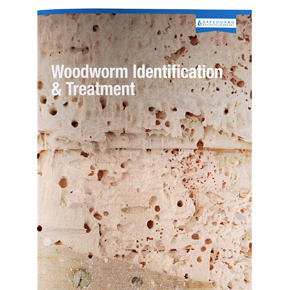
Listen to Safeguard and don’t let woodworm become a bugbear
Safeguard Europe has launched an incredibly useful guide which tackles the troublesome issue of larval infestation of timber; looking at how the cause can be accurately identified and the best solution to treating it.
A fair few species of ‘woodworm’ can be found in Britain; and for anybody associated with building maintenance or refurbishment, it is vital they can recognise them, as some woodworm can be more damaging that others.
The UK’s leading specialist in damp-proofing and waterproofing technology have introduced Woodworm Identification and Treatment. This guide is full of extensive colour photography, detailing the species you are likely to come across in the UK, from larvae to adult.
As well as identification, the publication also looks at what needs to be done to assess if a woodworm infestation is still active or has died out, and how to deal, long term, with small infestations of common species in an effective manner.
Some minor infestations can easily be dealt with by applying a high strength curative woodworm treatment, an example being Soluguard Woodworm Treatment.
However, there are others which will need a more in depth, extensive treatment by a professional company, with the recommendation they be a Property Care Association member.
The guide analyses a common confusion many people have; this is that ‘woodworms’ are worms and they are a damaging relation of the useful variety found in soil. In actual fact, woodworm are the wood-eating larvae, better known as maggots, of particular beetles.
The curative woodworm treatment method mentioned above sees the fluid applied to all surfaces of the affected timber. This kills adult beetles, which prevents them from reproducing.
However, it doesn’t kill larvae deeper than 2mm below the timber surface, so this type of surface treatment is only suitable for lighter infestations.
An important consideration when choosing woodworm treatment fluid is to differentiate between products tested under European Standards for either ‘curative’ or ‘preventative’ use – the latter use products of lower strength, meaning while new attacks on timber can be prevented, they cannot exterminate an existing infestation.
Heavier infestation, or those featuring more aggressive woodworm species, may require affected timber to be removed and replaced. Treatment with injected pastes or gels, like ProBor 20, could be used, as these have the ability to kill the larvae deep into the timber. NB- these are licensed by the HSE as only for professional use.
For a free copy of Safeguard’s Woodworm Identification and Treatment, visit www.safeguardeurope.com or email info@safeguardeurope.com.
Contact:
Safeguard Europe,
Redkiln Close,
Horsham,
West Sussex,
United Kingdom,
RH13 5QL
Phone: 01403 210204
Fax: 01403 217529
Visit Safeguard Europe's website
Visit Supplier's page
Latest news

11th April 2025
Don’t Do a Dave! It’s Time to Lock FIT Show 2025 in Your Calendar!
It’s that time again – FIT Show is back! You could be forgiven for thinking there won’t be much new to see when FIT Show returns to the NEC from 29 April – 1 May. Wrong!
Posted in Articles, Building Industry Events, Building Industry News, Building Products & Structures, Building Services, Continuing Professional Development (CPD's), Exhibitions and Conferences, Information Technology, Innovations & New Products, Restoration & Refurbishment, Retrofit & Renovation, Seminars, Training
11th April 2025
Insight Data: Boost construction success with project and prospect data
For those working in construction – in whatever capacity – the last few years haven’t been much fun. And according to the latest statistics, it would seem the challenges are continuing – Alex Tremlett, Insight Data’s Commercial Director, has more…
Posted in Articles, Building Industry News, Building Services, Information Technology, news, Research & Materials Testing
11th April 2025
ASSA ABLOY EMEIA: Learn how to tackle the security challenges of digitalising access with insights from industry experts
In a new series of videos, experts in various specialisms within ASSA ABLOY share their expertise on digital access, including the complexities to overcome and the range of benefits for those who get digital access right…
Posted in Access Control & Door Entry Systems, Architectural Ironmongery, Articles, Building Industry News, Building Products & Structures, Building Services, Doors, Facility Management & Building Services, Information Technology, Innovations & New Products, Posts, Restoration & Refurbishment, Retrofit & Renovation, Security and Fire Protection, Videos
10th April 2025
Geberit completes 150 Acts of Kindness
Geberit has raised nearly £14,000 for various charities through its ‘150 Acts of Kindness’ initiative, a year-long programme of fundraising and volunteering to mark the company’s 150th anniversary in 2024.
Posted in Articles, Bathrooms & Toilets, Bathrooms, Bedrooms & Washrooms, Building Industry Events, Building Industry News, Building Products & Structures, Building Services, Charity work, Drainage, Interiors, Pipes, Pipes & Fittings, Plumbing, Restoration & Refurbishment, Retrofit & Renovation
 Sign up:
Sign up: